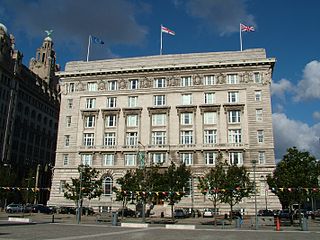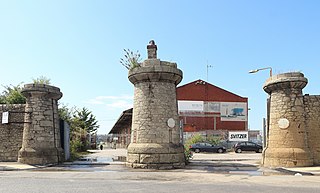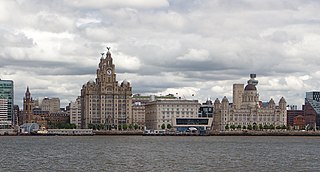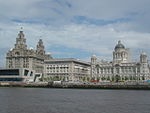Related Research Articles

World Heritage Sites are landmarks and areas with legal protection by an international convention administered by UNESCO for having cultural, historical, or scientific significance. The sites are judged to contain "cultural and natural heritage around the world considered to be of outstanding value to humanity".

In the United Kingdom, a listed building is a structure of particular architectural and/or historic interest deserving of special protection. Such buildings are placed on one of the four statutory lists maintained by Historic England in England, Historic Environment Scotland in Scotland, Cadw in Wales, and the Northern Ireland Environment Agency in Northern Ireland. The classification schemes differ between England and Wales, Scotland, and Northern Ireland. The term has also been used in the Republic of Ireland, where buildings are protected under the Planning and Development Act 2000, although the statutory term in Ireland is "protected structure."

The Cunard Building is a Grade II* listed building in Liverpool, England. It is located at the Pier Head and along with the neighbouring Royal Liver Building and Port of Liverpool Building is one of Liverpool's Three Graces, which line the city's waterfront. It is also part of Liverpool's former UNESCO designated World Heritage, the Maritime Mercantile City.

The Pier Head is a riverside location in the city centre of Liverpool, England. It was part of the former Liverpool Maritime Mercantile City UNESCO World Heritage Site, which was inscribed in 2004, but revoked in 2021. As well as a collection of landmark buildings, recreational open space, and a number of memorials, the Pier Head was the landing site for passenger ships travelling to and from the city.

The Port of Liverpool Building is a Grade II* listed building in Liverpool, England. It is located at the Pier Head and, along with the neighbouring Royal Liver Building and Cunard Building, is one of Liverpool's Three Graces, which line the city's waterfront. It is also part of Liverpool's formerly UNESCO-designated World Heritage Maritime Mercantile City.

Bramley-Moore Dock was a dock on the River Mersey in Liverpool, England, and part of the Port of Liverpool. The dock is located in the northern dock system in Liverpool's Vauxhall area, and was connected to Sandon Half Tide Dock to the north and Nelson Dock to the south. Jesse Hartley was the architect. The dock opened in 1848.

Stanley Dock is a dock on the River Mersey, England, and part of the Port of Liverpool. It is situated in the Vauxhall area of Liverpool and is part of the northern dock system. The dock is connected to the Leeds and Liverpool Canal to the east and Collingwood Dock to the west.

The Port of Liverpool is the enclosed 7.5-mile (12.1 km) dock system that runs from Brunswick Dock in Liverpool to Seaforth Dock, Seaforth, on the east side of the River Mersey and the Birkenhead Docks between Birkenhead and Wallasey on the west side of the river.

The Historic Centre of Macao is a collection of over twenty locations that witness the unique assimilation and co-existence of Chinese and Portuguese cultures in Macau, a former Portuguese colony. It represents the architectural legacies of the city's cultural heritage, including monuments such as urban squares, streetscapes, churches and temples.

The Dresden Elbe Valley is a cultural landscape and former World Heritage Site stretching along the Elbe river in Dresden, the state capital of Saxony, Germany. The valley, extending for some 20 kilometres (12 mi) and passing through the Dresden Basin, is one of two major cultural landscapes built up over the centuries along the Central European river Elbe, along with the Dessau-Wörlitz Garden Realm downstream.

Liverpool Waters is a large scale £5.5bn development that has been proposed by the Peel Group in the Vauxhall area of Liverpool, Merseyside, England. The development will make use of a series of presently derelict dock spaces at Central Docks. From 2004 to 2021, much of the docks involved in the development were part of the Liverpool Maritime Mercantile City, a UNESCO World Heritage Site, but the development of these docks were cited as a reason for the revocation of Liverpool's World Heritage status. This is an area north of Liverpool's historic Pier Head. It is the sister programme of the Wirral Waters project. Since 2012 the two projects have held enterprise zone statuses, together forming the Mersey Waters Enterprise Zone.

Liverpool Maritime Mercantile City is a former UNESCO designated World Heritage Site in Liverpool, England, that comprised six locations in the city centre including the Pier Head, Albert Dock and William Brown Street, and many of the city's most famous landmarks.

World Heritage Sites may lose their designation when the UNESCO World Heritage Committee determines that they are not properly managed or protected. The committee can place a site it is concerned about on its list of World Heritage in Danger of losing its designation, and attempts to negotiate with the local authorities to remedy the situation. If remediation fails, the committee then revokes its designation.

The architecture of Liverpool is rooted in the city's development into a major port of the British Empire. It encompasses a variety of architectural styles of the past 300 years, while next to nothing remains of its medieval structures which would have dated back as far as the 13th century. Erected 1716–18, Bluecoat Chambers is supposed to be the oldest surviving building in central Liverpool.

The Prudential Assurance Building is a Grade II listed, Victorian Gothic revival style office building located on Dale Street in the centre of Liverpool, England.
Liverpool is a city and port in Merseyside, England, which contains many listed buildings. A listed building is a structure designated by English Heritage of being of architectural and/or of historical importance and, as such, is included in the National Heritage List for England. There are three grades of listing, according to the degree of importance of the structure. Grade I includes those buildings that are of "exceptional interest, sometimes considered to be internationally important"; the buildings in Grade II* are "particularly important buildings of more than special interest"; and those in Grade II are "nationally important and of special interest". Very few buildings are included in Grade I — only 2.5% of the total. Grade II* buildings represent 5.5% of the total, while the great majority, 92%, are included in Grade II.

There are over 2500 listed buildings in Liverpool, England. A listed building is one considered to be of special architectural, historical or cultural significance, which is protected from being demolished, extended or altered, unless special permission is granted by the relevant planning authorities. Of the listed buildings in Liverpool, 27 are classified as Grade I listed and are recognised as buildings of outstanding architectural or historic interest. The following list provides information on all the Grade I listed buildings in the city.

Everton Stadium is a football stadium under construction on Bramley-Moore Dock in Vauxhall, Liverpool, England, that will become the home ground for Everton ahead of the 2025–26 season, replacing Goodison Park.

George's Dock Building is a Grade II listed building in Liverpool, England. It is located at the Pier Head on the city's waterfront. It is part of Liverpool's former UNESCO designated World Heritage Maritime Mercantile City. It was built in the 1930s in the Art Deco style, and designed by architect Herbert Rowse. Occupants of the office space include, Merseytravel, The Liverpool City Region Combined Authority, Mersey Tunnels staff and The Mersey Tunnels Police. It also houses ventilation machinery for the Queensway Tunnel and the Mersey Tunnels Tour Offices.
References
- 1 2 "Listed buildings" (PDF). Liverpool City Council. Archived from the original (PDF) on 27 September 2013. Retrieved 22 July 2013.
- ↑ "Grade I listing for synagogue". BBC. 3 March 2008. Retrieved 11 July 2009.
- ↑ "Liverpool stripped of Unesco World Heritage status". BBC News. 21 July 2021. Retrieved 21 July 2021.
- ↑ Hughes (1999), p11
- ↑ Hughes (1999), p10
- ↑ "Listed buildings". Liverpool City Council. Archived from the original on 17 October 2008. Retrieved 21 September 2008.
- ↑ "Historic Britain: Liverpool". HistoricBritain.com. Retrieved 13 July 2009.
- ↑ "Merseyside Facts". The Mersey Partnership. 2009. Archived from the original on 19 September 2007. Retrieved 13 July 2009.
- ↑ "Heritage map for changing city". BBC News . 19 March 2002. Retrieved 11 July 2009.
- ↑ ""Liverpool - Maritime Mercantile City"" . Retrieved 26 May 2008.




